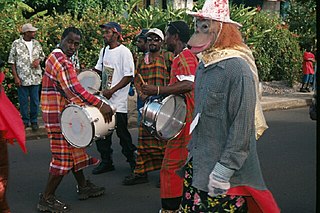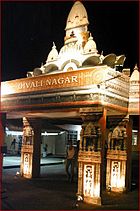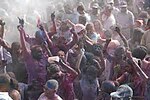
This article is about the demography of the population of Trinidad and Tobago including population density, ethnicity, education level, health of the populace, economic status, religious affiliations and other aspects of the population.
Soca music is a genre of music defined by Lord Shorty, its inventor, as the "Soul of Calypso", which has influences of African and East Indian rhythms. It was originally spelled "sokah" by its inventor but through an error in a local newspaper when reporting on the new music it was erroneously spelled "soca"; Lord Shorty confirmed the error but chose to leave it that way to avoid confusion. It is a genre of music that originated in Trinidad and Tobago in the early 1970s and developed into a range of styles during the 1980s and after. Soca was initially developed by Lord Shorty in an effort to revive traditional calypso, the popularity of which had been flagging amongst younger generations in Trinidad due to the rise in popularity of reggae from Jamaica and soul and funk from the United States. Soca is an offshoot of calypso/kaiso, with influences from East Indian rhythms and hooks.
Calypso is a style of Caribbean music that originated in Trinidad and Tobago during the early to mid-19th century and spread to the rest of the Caribbean Antilles by the mid-20th century. Its rhythms can be traced back to West African Kaiso and the arrival of French planters and their slaves from the French Antilles in the 18th century.
The music of Trinidad and Tobago is best known for its calypso music, soca music, chutney music, and steelpan. Calypso's internationally noted performances in the 1950s from native artists such as Lord Melody, Lord Kitchener and Mighty Sparrow. The art form was most popularised at that time by Harry Belafonte. Along with folk songs and African- and Indian-based classical forms, cross-cultural interactions have produced other indigenous forms of music including soca, rapso, parang, chutney, and other derivative and fusion styles. There are also local communities which practice and experiment with international classical and pop music, often fusing them with local steelpan instruments.

The music of Dominica includes a variety of genres including all the popular genres of the world. Popular music is widespread, with a number of native Dominican performers gaining national fame in imported genres such as calypso, reggae, soca, kompa, zouk and rock and roll. Dominica's own popular music industry has created a form called bouyon, which combines elements from several styles and has achieved a wide fanbase in Dominica. Groups include WCK, Native musicians in various forms, such as reggae, kadans (Ophelia Marie, and calypso, have also become stars at home and abroad.
The music of the Lesser Antilles encompasses the music of this chain of small islands making up the eastern and southern portion of the West Indies. Lesser Antillean music is part of the broader category of Caribbean music; much of the folk and popular music is also a part of the Afro-American musical complex, being a mixture of African, European and indigenous American elements. The Lesser Antilles' musical cultures are largely based on the music of African slaves brought by European traders and colonizers. The African musical elements are a hybrid of instruments and styles from numerous West African tribes, while the European slaveholders added their own musics into the mix, as did immigrants from India. In many ways, the Lesser Antilles can be musically divided based on which nation colonized them.
J'ouvert or Jour ouvert is a traditional festival known as "break day" or the unofficial start of Carnival, which takes place on the Monday before Ash Wednesday. The festival, with origins in Trinidad, traditionally begins at 2 a.m. and continues until mid-morning on Monday. J'ouvert revellers cover their bodies in coloured paints, mud, pitch oil, dress as blue or red devils to dance the streets as an expression of liberation from the constraints of the past and in celebration of the ancestors who have gone before them. Other neighbouring islands, and in areas where Caribbean people have immigrated, celebrate J'ouvert before the official start of Carnival Mas, where the more elaborate costumes are on display and danced through the city streets.
Parang is a popular folk music originating from Venezuela and Trinidad and Tobago that was brought to Trinidad and Tobago by Venezuelan migrants who were primarily of Amerindian, Spanish, Mestizo, Pardo, and African heritage, something which is strongly reflected in the music itself. The word is derived from two Spanish words: parranda, meaning "a spree”, and parar meaning "to stop".
Chutney music is a fusion genre of Indian folk music, specifically Bhojpuri folk music, with Caribbean calypso and soca music, and later with Bollywood music. This genre of music that developed in Trinidad and Tobago is popular in Trinidad and Tobago, Guyana, Suriname, Jamaica, other parts of the Caribbean, Fiji, Mauritius, and South Africa. Chutney music emerged mid-20th century and reached a peak of popularity during the 1980s. Several sub-genres have developed.

The music of Antigua and Barbuda is largely African in character, and has only felt a limited influence from European styles due to the population of Antigua and Barbuda descending mostly from West Africans who were made slaves by Europeans.

The Trinidad and Tobago Carnival is an annual event held on the Monday and Tuesday before Ash Wednesday in Trinidad and Tobago. This event is well known for participants' colorful costumes and exuberant celebrations. There are numerous cultural events such as "band launch fetes" running in the lead up to the street parade on Carnival Monday and Tuesday. It is said that if the islanders are not celebrating it, then they are preparing for it, while reminiscing about the past year's festival. Traditionally, the festival is associated with calypso music, with its origins formulated in the midst of hardship for enslaved West and Central Africans; however, recently Soca music has replaced calypso as the most celebrated type of music. Costumes, stick-fighting and limbo competitions are also important components of the festival.

Indo-Trinidadians and Tobagonians or Indian-Trinidadians and Tobagonians are people of Indian origin who are nationals of Trinidad and Tobago, whose ancestors came from India and the wider subcontinent beginning in 1845 during the period of colonization.
Indo-Caribbean Americans or Indian-Caribbean Americans, are Americans who trace their ancestry ultimately to India, though whose recent ancestors lived in the Caribbean, where they migrated beginning in 1838 as indentured laborers. There are large populations of Indo-Trinidadian and Tobagonians and Indo-Guyanese along with a smaller population of Indo-Surinamese, Indo-Jamaicans and other Indo-Caribbeans in the United States, especially in the New York metropolitan area and Florida. The Washington metropolitan area, Texas, and Minnesota also have small numbers of Indo-Guyanese and Indo-Trinidadians. Indo-Caribbean Americans are a subgroup of Caribbean Americans as well as Indian Americans, which are a subgroup of South Asian Americans, which itself is a subgroup of Asian Americans.
Edwin Ayoung, better known as Crazy, is a Trinidadian calypsonian. He has been active since the mid-1970s and is one of the most successful artists from Trinidad and Tobago.
In Trinidad and Tobago, Guyana, and Suriname, chutney soca music is a crossover style of music incorporating soca and calypso elements and English, Hindustani, and Hinglish lyrics, chutney music, with Western instruments such as the guitar, piano, drum set, and Indian instruments such as the dholak, harmonium, tabla, and dhantal.

Caribbean Hindustani is an Indo-Aryan language spoken by Indo-Caribbeans and the Indo-Caribbean diaspora. It is a koiné language mainly based on the Bhojpuri and Awadhi dialects. These Hindustani dialects were the most spoken dialects by the Indians who came as immigrants to the Caribbean from Colonial India as indentured laborers. It is closely related to Fiji Hindi and the Bhojpuri-Hindustani spoken in Mauritius and South Africa.

Denyse Burnadette Kirline Plummer was a Trinidadian calypsonian and gospel singer. The child of a white father and a black mother, she initially faced significant prejudice in a genre traditionally seen as Afro-Caribbean, but was eventually recognised as a leading calypso performer. In 2001, she won the Calypso Monarch title with her songs "Heroes" and "Nah Leaving".
Kenwrick Joseph, known professionally as Kenny J, was a Trinidad and Tobago calypsonian and Assistant Superintendent of Police who was best known for his soca parang hits including The Paint Brush.















